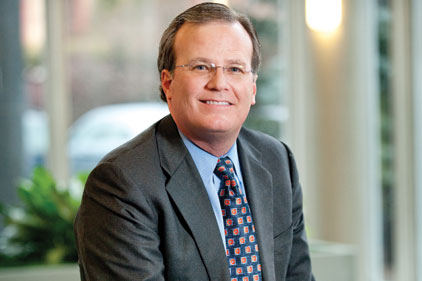On the Track of OSAC: The Country-Council Chronicles -- Final Entry
Day 8: Baghdad/Amman/Home

John McClurg, VP, Chief Security Officer, Dell Global Security and 2011 OSAC Co-Chair
Editor's note: John McClurg, VP, Chief Security Officer for Dell Global Security, is also the 2011 co-chair for the Overseas Security Advisory Council (OSAC). Security magazine is pleased to share his chronicles with you as he travels around the world to visit with OSAC's constituents, to allow for greater collaboration and to safeguard the lives and business interests of Americans abroad. This is John's final blog entry for this trip.
Day 8: Baghdad/Amman/Home
We arose before dawn to meet our Security Detail for the ride back to the airport. Although there appeared to be more than just a few large commercial craft parked at the gates of the International terminal, including a large 747, our selected mode of travel this morning was a C-130 managed by what‘s affectionately known as “State Air”. My father used to fly one of these back in Vietnam. As we advanced two by two up its lowered rear ramp, battling our way through the noxious fumes of its churning engines, I had the uneasy impression that this might actually be one that he flew. We took positions facing each other down a long bank of strap seats (I’ll never complain about the seating in commercial carriers again). We were told that due to the lingering possibility of small arms fire, we were to keep our PPE (Personal Protection Equipment) on until out of Iraqi airspace.
An hour and half later, our travel-weary team arrived in Amman. As we cleared customs, we learned two lessons that others may want to note: first, if you’re transiting Jordan within a period of less than 24 hours--and have tangible proof of that--you will not be required to buy a visa; and secondly, “tangible” proof must take the form of some paper…they’re not quite prepared to accept a PDA’s image as proof of your onward journey.
We made our way via rental car through the ubiquitous white stone structures that make up the skyline of Amman, arriving finally at our hotel, from where--after a brief respite--we made our way to the U.S. Embassy, a beautiful, relatively-new architectural structure. As their counterparts did before them, we were graciously received by the RSO and his team, who sat with us and discussed the attention-grabbing force of the events then churning in Egypt and what appeared to be the cascading collateral events emerging in neighboring locations. Jordan, however, has actually been experiencing peaceful demonstrations since mid-January, including sizable gatherings in Amman—and has yet to experience the level and type of unrest being manifest in other countries, partly due to the recent implementation of economic policies designed to provide some short-term relief, as well as a shakeup in the government following the resignation of the prime minister.
After our meetings, we were met by Anne Beecroft, the wife of Ambassador Steve Beecroft, both college friends of mine, who introduced us to the U.S. Department of State’s ART in Embassies Program, by sharing with us paintings she and the Ambassador had selected from galleries and private collections around the United States for display in the official American ambassadorial residence. I immediately recognized the work of Wulf Erich Barsch. We learned that they had intentionally sought pieces that they thought demonstrated “essential truths about American culture” in a way that would speak to the hearts and minds of the many Jordanian friends and official visitors that would visit their home.
All in all, ours was a very kind reception, particularly at a time fraught with compelling other distractions. The experience we had as we viewed the residence’s exhibit of Barsch paintings with their plethora of palms was a fitting conclusion to our journeys. Just as those palms symbolize figurative and literal sanctuary from the suns and winds of the region, the hospitality of the Ambassador and Anne, in like manner, was gratefully received. That two Texicans could serendipitously arrive at the Amman Embassy just when they were having their annual Chili Cook-off made it all the better. Anne invited us to join her and members of the Embassy “family” for this charity event that unmistakably conveyed the closeness that makes up these communities of public servants scattered around the globe.
I hope Anne will let us know if the “Maryland” chili submission came off conqueror.
As we were preparing to depart, the Ambassador took a break from the pressing business at hand to bid us good-bye. We took the occasion to assure him that in the days, weeks and months ahead, OSAC remains his committed partner in engaging and eventually overcoming the challenges we will face in the region.
Later that evening the team converged for a last time in the lobby of the hotel to bid each other good-bye--ending as we began—only this time in reverse as each departed for their respective destinations somewhere in the world. It has been an amazing eight days, the value of which we believe has more than validated the concept of the “road trip” that Peter and I first conceived back in November.
P.S. For those of you that have been following us from the beginning and were wondering…Peter did at long last recover his missing luggage. It finally caught up with him on the next to last day in Baghdad.
This then is our final installment of this iteration of the Country Council Chronicles. I’d like to thank again, our friends at Security Magazine, Diane Ritchey and Mark McCourt, for hosting our blog. Our next iteration will follow our sojourns to the cartel-plagued, border cities of Mexico, planned tentatively for some time in the Second Quarter. We’d invite you to join us again then as we chronicle those experiences and to join us--if you’re not already--as an official constituent of OSAC.( www.osac.gov )
